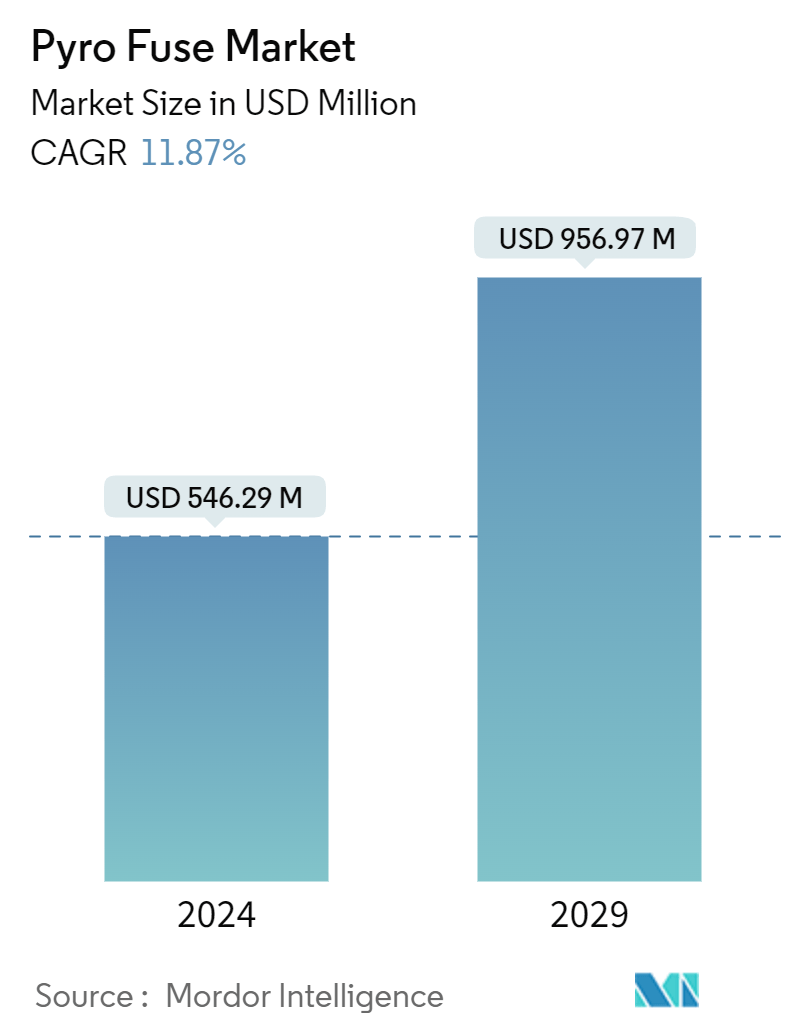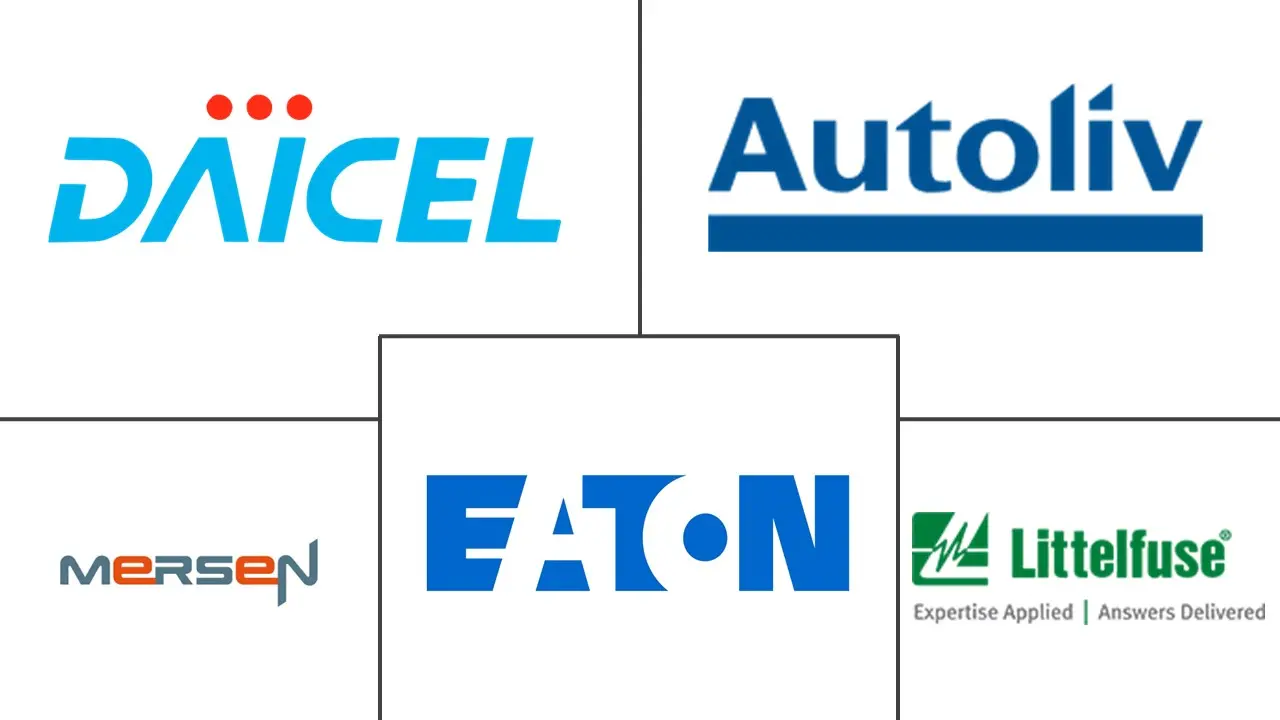Market Size of Pyro Fuse Industry

| Study Period | 2019 - 2029 |
| Market Size (2024) | USD 546.29 Million |
| Market Size (2029) | USD 956.97 Million |
| CAGR (2024 - 2029) | 11.87 % |
| Fastest Growing Market | Asia Pacific |
| Largest Market | Asia Pacific |
| Market Concentration | Medium |
Major Players
*Disclaimer: Major Players sorted in no particular order |
Pyro Fuse Market Analysis
The Pyro Fuse Market size is estimated at USD 546.29 million in 2024, and is expected to reach USD 956.97 million by 2029, growing at a CAGR of 11.87% during the forecast period (2024-2029).
- Pyrofuses facilitate rapid clearance of fault currents and minimize cost and weight compared to conventional mechanical breakers. Pyrofuses can tune the time-current curve to fit the application's fault response characteristics.
- For low-level voltages, pyro fuses can be utilized instead of a contactor, but they are not inherently safe as they require a signal. However, they can be independent of the fuse and can be set to trigger with any current from a current sensor. At over 3000 A DC, a contactor can break down, and the fuse must handle the current. Notably, the pyro fuse takes a different approach, utilizing the signal from the airbag's ECU to trigger a pyrotechnic ignitor, which punches through the busbar to sever the connection physically.
- According to the United Nations Industrial Development Organization, there was a 2.3% growth in industrial sectors, encompassing manufacturing, mining, electricity, water supply, waste management, and other utilities, signaling a post-pandemic recovery globally. Some hazardous industries, including oil and gas, will remain important as affordable, reliable, and versatile energy products for a growing global population.
- According to the International Energy Agency, oil and gas combined accounted for more than 50% of global energy demand in 2019, and it is expected in the long term that energy demand will still grow by 25% by 2040. Oil and gas extraction activities have the potential to cause damage to or destruction of property and the environment. They could even lead to injury and loss of life, particularly if the activity is not controlled, monitored, or regulated appropriately.
- Safety hazards associated with oil and gas extraction activities include but are not limited to vehicle collisions, explosions, and fires. Safety hazards related to confined space include ignition of flammable vapors or gases and electrical and other hazardous energy.
- As a result, governments worldwide are compelled to enforce strict safety regulations due to the rising number of accidents and explosions in the industry. The expanding energy requirements and the growing exploration activities in offshore and onshore oil fields present a substantial opportunity for the market to establish a foothold in this sector.
- In the oil and gas industry, modern electrical equipment is specifically engineered to withstand the demanding conditions of various processes within the oil and gas industry, including motor controls and supports. As the utilization of electrical equipment continues to rise across the industry, there is a growing requirement for pyro-fuse to mitigate the risk of explosions.
Pyro Fuse Industry Segmentation
The pyro-fuse market is defined by the revenue generated through the sales of different pyro-fuses for various end-user industries in different regions worldwide. The study also tracks the key market parameters, underlying growth influencers, and major vendors operating in the industry, which supports the market estimations and growth rates over the forecast period.
The pyro-fuse market is segmented by voltage type (high voltage (more than 700 V), medium voltage (between 400 V to 700 V), and low voltage (below 400 V)), applications (automotive and industrial), and geography (North America, Europe, Asia-Pacific, Latin America, and Middle East and Africa). The market sizes and forecasts are provided in terms of value in USD for all the above segments.
| By Voltage Type | |
| High Voltage (More than 700 V) | |
| Medium Voltage (Between 400 V to 700 V) | |
| Low Voltage (Below 400 V) |
| By Application | |
| Automotive | |
| Industrial |
| By Geography | |
| North America | |
| Europe | |
| Asia | |
| Australia and New Zealand | |
| Latin America | |
| Middle East and Africa |
Pyro Fuse Market Size Summary
The pyro fuse market is poised for significant growth, driven by its critical applications in both the automotive and industrial sectors. Pyro fuses offer advantages over traditional mechanical breakers by facilitating rapid fault current clearance while reducing cost and weight. Their ability to integrate with current sensors and trigger mechanisms, such as those used in airbag systems, enhances safety in high-voltage environments. The automotive industry, particularly with the rise of electric vehicles, is a major contributor to this market expansion. Pyro fuses are essential in preventing overheating and ensuring the safety of electric vehicle systems by disconnecting high-voltage batteries during accidents. The increasing adoption of electric vehicles, supported by government initiatives and consumer demand, is expected to drive the demand for pyro fuses in the region.
In addition to the automotive sector, the industrial applications of pyro fuses are gaining traction, especially in the oil and gas industry, where they are used to mitigate explosion risks in electrical equipment. The Asia-Pacific region, with its robust industrial base and growing electric vehicle market, is a key driver of market growth. Countries like China, India, and South Korea are witnessing increased adoption of electric vehicles and advanced electrical equipment, further boosting the demand for pyro fuses. The market is semi-consolidated, with major players like Daicel Corporation, Autoliv Inc., and Eaton Corporation actively engaging in partnerships and innovations to enhance their offerings. As the global focus shifts towards energy efficiency and safety, the pyro fuse market is expected to expand, leveraging opportunities in both automotive and industrial applications.
Pyro Fuse Market Size - Table of Contents
-
1. MARKET INSIGHTS
-
1.1 Market Overview
-
1.2 Industry Attractiveness - Porter's Five Forces Analysis
-
1.2.1 Bargaining Power of Suppliers
-
1.2.2 Bargaining Power of Buyers
-
1.2.3 Threat of New Entrants
-
1.2.4 Threat of Substitutes
-
1.2.5 Degree of Competition
-
-
1.3 Industry Value Chain Analysis
-
1.4 Impact of Macro Trends in the Market
-
-
2. MARKET SEGMENTATION
-
2.1 By Voltage Type
-
2.1.1 High Voltage (More than 700 V)
-
2.1.2 Medium Voltage (Between 400 V to 700 V)
-
2.1.3 Low Voltage (Below 400 V)
-
-
2.2 By Application
-
2.2.1 Automotive
-
2.2.2 Industrial
-
-
2.3 By Geography
-
2.3.1 North America
-
2.3.2 Europe
-
2.3.3 Asia
-
2.3.4 Australia and New Zealand
-
2.3.5 Latin America
-
2.3.6 Middle East and Africa
-
-
Pyro Fuse Market Size FAQs
How big is the Pyro Fuse Market?
The Pyro Fuse Market size is expected to reach USD 546.29 million in 2024 and grow at a CAGR of 11.87% to reach USD 956.97 million by 2029.
What is the current Pyro Fuse Market size?
In 2024, the Pyro Fuse Market size is expected to reach USD 546.29 million.

